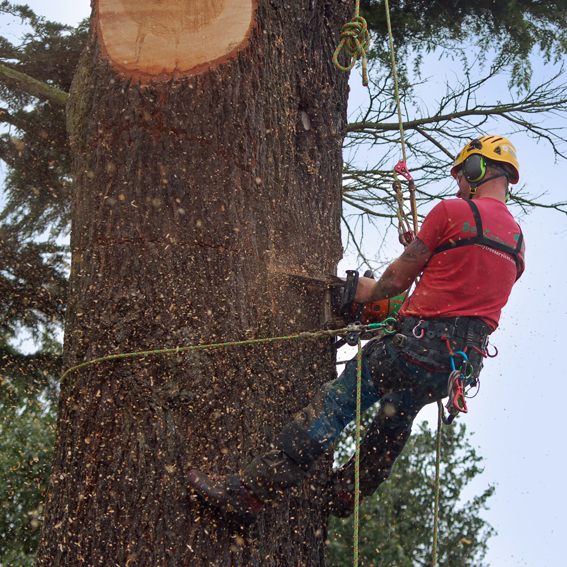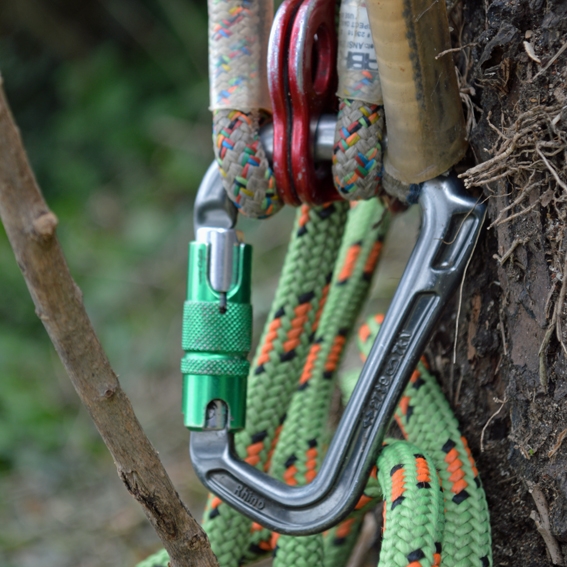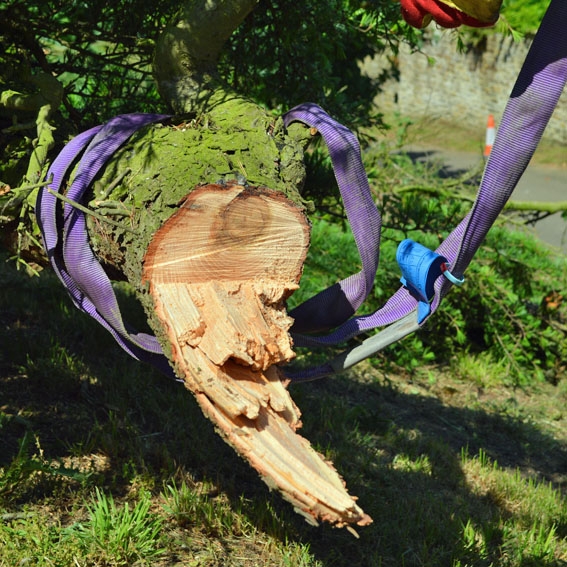
Buyers Guide to Karabiners & Slings
Karabiners and slings (also known as strops) are vital components of the tree surgeon’s armoury. There’s a host of different products available, and understanding the functions and uses of specific items of kit is important to both efficiency and safety.
Climbing karabiners and slings are used to enable the climber to ascend, descend, and move around the canopy of the tree. Any items of gear for personal safety have very specific safety standards they must meet, must be individually identifiable (with a serial or ID number) and of course, must comply with the correct standard for the intended use.
Rigging (or lowering) karabiners and slings, on the other hand, are used to lower and move heavy loads like tree limbs. As such, rigging equipment usually has higher strength ratings but less stringent labelling requirements.
Rigging and climbing systems are only as good as their weakest elements, and so it’s vital that you understand the forces at play, for example, the effects of shock loading, and the correlation between breaking strengths and working loads – and match correctly rated products to the scenario on hand.
Safety First
Buying karabiners and slings might often be overlooked as a simple purchase, but picking the right equipment will allow you to get the job completed efficiently and safely.
Climbing Gear
The first key point is that any climbing equipment must, of course, meet the relevant standard. Karabiners must comply with BS EN 362:2004, which is the European Safety Standard for connectors used for PPE against falls from height.
Slings or strops come into various categories depending on the intended use. For example, positioning lanyards need to meet EN358; endless tape slings should meet EN795 and EN566.
Some products that have multiple uses will meet a number of standards, for example, the Sirius MultiSling meets EN795B (the standard for “anchor devices”), EN566 (“slings”) and EN564 (“accessory cord”) meaning that this product is suitable for various uses. Whatever you intend to use a product for, it should meet the relevant standard. This HSE document on European standard and markings for fall arrest sets out the requirements, test methods and marking that’s required.
On top of that, the Lifting Operations and Lifting Equipment Regulations (LOLER) also set out requirements that cover climbing gear. Any equipment designed for people has to be marked with a minimum breaking strain (MBS) or safe working load (SWL).

Rigging Gear
It is equally important that you select the right lowering equipment for the task that you are carrying out. Not only will this help minimise the risk of accident, but it will also prolong the life of your equipment and in some cases, help protect the wellbeing of the tree.
Strops used for rigging do not have the same stringent requirements as those used for PPE – for example, most lowering slings are not required to be tested to any EN standard – however, they do still come under the regulations of LOLER. This requires that items used to lift or lower loads such as tree sections, branches, or limbs are marked with an MBS or SWL.
Choosing The Right Equipment
Here is a brief buyer’s guide to some of the best karabiners and slings for arborists and tree workers:
Climbing Karabiners
Karabiners come in a wide range of shapes and sizes and whilst in some situations they are interchangeable, you’ll find that certain types better fit particular requirements.
A karabiner consists of three parts: the gate (the spring-loaded part that opens inwards so you can attach your rope or harness); the spine (located opposite the gate which acts as its backbone and carries the force and weight of the arborist); and the nose (essentially where the gate and spine meet).
When purchasing a karabiner, consider its shape, gate type, size and weight. Do you want a small compact karabiner for a minimised system? Does it need to fit the eye of another piece of equipment? Do you want a variety of karabiners so you can quickly visually identify different components of your climbing system?
Karabiners can basically be categorised into four shapes: pear, D shape, and oval.
Oval karabiners, given their symmetrical shape, can be rotated or flipped around, making them the ideal choice for many uses. The smaller profile and consistent curve also often better fits them for small eyes in devices, as it allows them to move freely through the eye.
Pear-shaped karabiners usually have wider gate openings, allowing for easy clipping or the insertion of multiple components.
All karabiners used for climbing needs to have a 3-way locking gate mechanism to prevent accidental opening and keep the arborist safe.
Here are our best selling karabiners for climbing work:
This climbing karabiner has a symmetrical 110mm long oval design which makes it perfect for hitch systems or any application where direct alignment of two components is helpful or necessary. Safe to 24kN MBS and conforms to EN362.
HMS karabiners are offset or curved on one side. The term HMS comes from the German word, “Halbmastwurfsicherung”, which is a knot known as the Munter Hitch in English. The HMS karabiner shape allows a climber to use the Munter Hitch for smooth belaying without the rope jamming. This HMS alloy karabiner is 111mm long, conforms to EN362, and has a breaking strain of 23kN.
The DMM Shadow karabiner is a neat little 102mm in length, has a locksafe gate and an I-beam style profile which serves to increase its strength to weight ratio. Can hold 24kN and, like all our other climbing karabiners, conforms to EN362. The compact size of this karabiner allows it to sit very neatly in the hand.

Climbing Strops and Slings
Climbing strops and slings cover a variety of uses, the most common probably being for positioning or redirects.
Positioning strops (or lanyards) provide horizontal support and allow the climber to adjust his or her position towards or away from the trunk as they work. These can be as simple as a split tail with a prussic attached, or as streamlined and slick as the Teufelberger HipSTARflex lanyard.
Endless tape slings are made of nylon or dyneema tape strongly sewn into a continuous loop. They come in a variety of lengths, depending on what you’ll need for the task.
You’ll come across various other strops too, such as tool strops for securing a chainsaw to your climbing harness, split tails for using as a blake’s hitch on your main climbing line instead of a prussic or friction hitch – or as a short rope for creating a redirect – or more specialist products such as the multiSLING or ringLOOP.
This is an adjustable work positioning lanyard that is custom designed for arborist work positioning. The Zillion is deployed to distribute the load on the harness’s waistbelt and is easily adjustable and lockable/unlockable using only one hand.
This 3-metre Lanyard conforms to EN358 and uses the hitch climber system with a Pinto pulley, allowing for easy length adjustment. The Ocean Vectran rope with thimble is intended as an additional mounting point.
1.2 metre long 25mm wide polyamide sling with a maximum breaking strain of 30kN, conforming to EN795 EN566.

Rigging Karabiners
A professional arborist will always need a decent selection of robust steel karabiners.
There’s the option of offset-D which is asymmetric and allows the gate to be opened wider than a true ‘D’ karabiner; the ultimate example of this is the Iron Wizard which has a clever off-axis gate to give maximum opening space and an impressive 7-tonne breaking strain.
Most popular are the HMS shaped Klettersteig or pear-shaped Big Dan, due to their large capacity to take bulky slings or other components and a robust 5-tonne load rating.
Generally, a variety of sizes and shapes is a good idea. Here are three popular ones we’d recommend:
This is a compact screwgate karabiner with a 35kN MBS. At only 102mm long it comes into it’s own when you need a smaller connector, or to minimise weight when the climber needs to carry some spares. Fully conforms with EN362.
This karabiner has a 3-way locking gate and again has a 50kN MBS. Fully compliant with EN362.
This supersafe 3-way action karabiner greatly reduces the risk of the gate opening by accident. At 133mm length and weighing 278 gram, it has a 50kN maximum breaking strain and, like all our rigging karabiners, conform to EN362
Rigging Slings
Slings come in two main types; rope slings and round slings.
Rope slings cover various uses. Deadeye sling is like a giant split tail – a length of rope with an eye one end designed for securing a rigging pulley to a branch. A whoopie sling is used at the base of a tree to anchor a friction brake device such as a capstan.
Round slings are made from a continuous loop of yarn and with a stronger jacket. This makes them capable of taking very heavy loads. Due to their endless circular design, round slings can easily be choked around a branch of any diameter.
Here are some slings that we recommend:
This sling is specifically designed for fast and easy rigging and can be used as a base anchor or high anchor – so it essentially does the job of a dead eye or a whoopie sling. The rope length can be easily adjusted by pulling it through the Spiderplate, even after installation. When under load, the length locks, and then immediately releases when the load is removed. The rope has been pre-stretched and comes with an abrasion resistant coating for durability. The total length is 2.5m with a breaking strain of 50kN.
This is an 18mm diameter rope with a length of 10 metres. It’s a dead-eye sling which has one spliced and protected eye. The maximum breaking strain is a substantial 92kN for heavy loads. The length of this is to allow it to be used as a base anchor on larger trees where a whoopie sling isn’t long enough.
A deceptively strong rope sling, the Whoopie Extreme Sling is made from Dyneema which is five times lighter, yet 40 per cent stronger, than braided rope. It stretches very little and resists abrasion very well. The water-resistant properties make it highly suitable for outdoor work and the length can be adjusted from 1.1 metres to 3.6 metres. It will fit around a trunk with a 90cm girth and has an impressive breaking strain of 65kN.
A continuous filament sling that has a 3-tonne working load and 3-metre taut length. The most common use for round slings is to anchor limbs prior to cutting, but they’re also useful when winching. 3T x 3m is a commonly used size but we also stock round slings in 2 tonne and 5 tonne versions.
